Heading out the door? Read this article on the new Outside+ app available now on iOS devices for members! Download the app.
When autumn officially rolls around, there are a few things you can expect: The temperatures will plummet, pumpkin spice lattes will reappear, and not only will fall winds kick up, so will your obligations.
When this happens, it can be easy to feel a little (or, let’s be honest, a lot) spun out, ungrounded, and overwhelmed. According to the science of Ayurveda, that is your vata, or air element, and it creates all of those airy, drying, cooling characteristics—outside as well reflected in your life. The tendency when you’re feeling rushed or ungrounded is to practice yoga as intensely as you feel, yet adding more of that energy to your day only contributes to feeling like you’re going into a centrifuge.
What brings relief is moving slowly. You still want to create strength through standing postures, build heat through twists, and engage in enough joint movement to release synovial fluid and counteract dryness. This balancing approach of slower transitions, longer holds, and longer exhales can create a grounding and balancing effect in your body and in your thoughts, even through times of transition.
See also: Feeling Spacey and Ungrounded? Your Vata Dosha Could Be Out of Balance
Grounding yoga poses for your vata dosha
Warmup
Begin with a Cat and Cow flow, followed by Plank held for at least 5 breaths to prepare your hands and wrists to bear weight, and three Surya Namaskar A (Sun Salutation A) flows.

Core twist
Come to your back on the mat with your knees bent and your feet flat on the mat. Bring your right shin to your left thigh in a Figure 4. Place your left hand behind your head. Your right hand can extend slightly to your side to brace you.
On an exhalation, lift your head and shoulder blades off the mat and turn to “crunch” to the right knee, aiming the left side of your chest toward your knee. On an inhalation, slowly lower your head to the mat. As you repeat, keep your head heavy in your hand, and resist doing the work with the arm; instead, keep your left elbow open to its side. Let your core initiate the movement. Crunch for 1 minute. Repeat on the other side.
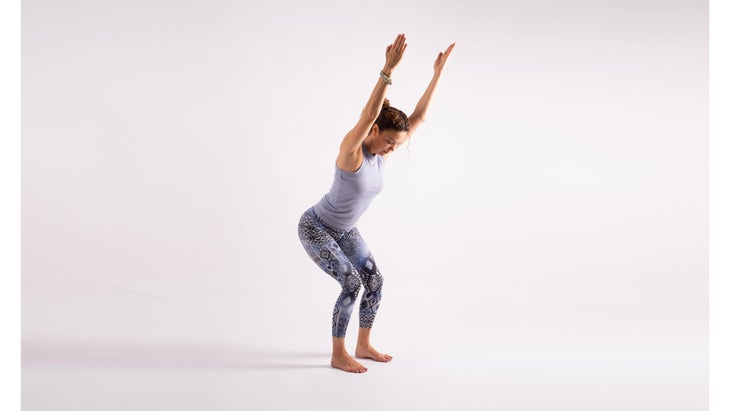
Utkatāsana (Chair Pose), variation
Come to stand at the front of the mat with your feet hip-width apart. On an inhalation, “sit” back into Utkatasana (Chair Pose) and raise your arms alongside your ears. Look down at your knees. Are they pointing toward the inside of your toes, or toward the outside? Try pointing the center of your kneecap in the exact direction that your toes are pointing, even if that means moving them ¼ inch. Feel yourself grounding into the mat. Explore the pose for up to 10 breaths and, when you build heat in the legs, exhale and bend forward into Uttanasana (Standing Forward Bend).
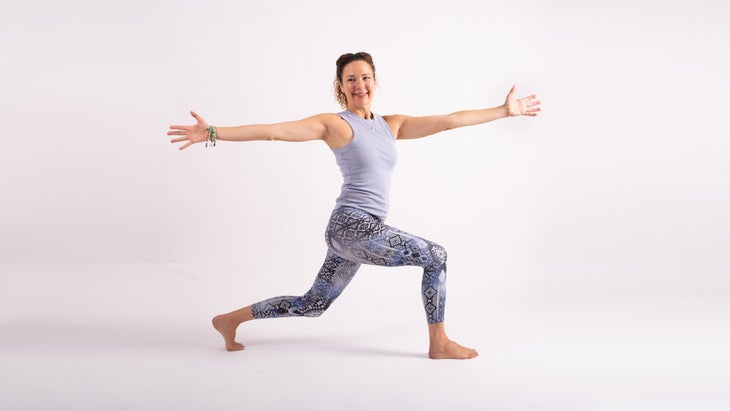
High Lunge twists
From Standing Forward Bend, step your left foot back to Anjaneyasana (Low Lunge). Grounding into your front heel, slowly lift yourself to High Lunge with your arms reaching alongside your ears. Stabilize yourself by engaging your legs as though you’re drawing them toward the center of the mat and keeping your gaze steady and soft. On your next exhalation, open your arms and twist to the right as you lower your back knee toward the earth. Use the inhale to slowly return to High Lunge with a straight back leg. Repeat this slow flow at least 4 times. Play with how slow and how low you can go.
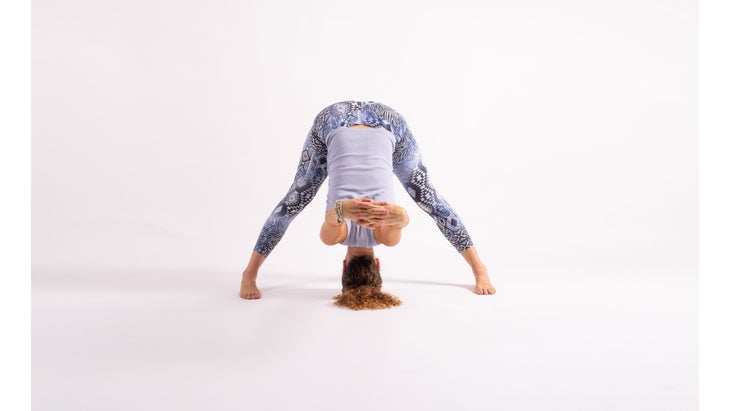
Prasarita Padottanasana C (Wide-Legged Standing Forward Bend)
From High Lunge, on your next exhalation, pivot your back heel down, straighten your legs and turn to face the left long side of your mat in a wide-legged stance with your toes turned in ever so slightly. Interlace your fingers behind your back with your right thumb beginning the lacing for Prasaraita Padottanasana C or instead hold onto a towel or strap with both hands.
Inhale and lift your chest, exhale and forward fold without locking your knees. Allow your head to be heavy and your neck relaxed, which will bring some traction to the spine. You might want to bring your hands up and over your head to open your shoulders. Explore the pose for at least 5 breaths. Release your hands to the mat.
From Wide-Legged Standing Forward Bend, inhale and lengthen your spine with your arms long. Exhale and walk your hands to the front of the mat, pivoting into a lunge. Step to the front of the mat, and repeat High Lunge twists and Wide-Legged Standing Forward Bend on the other side.
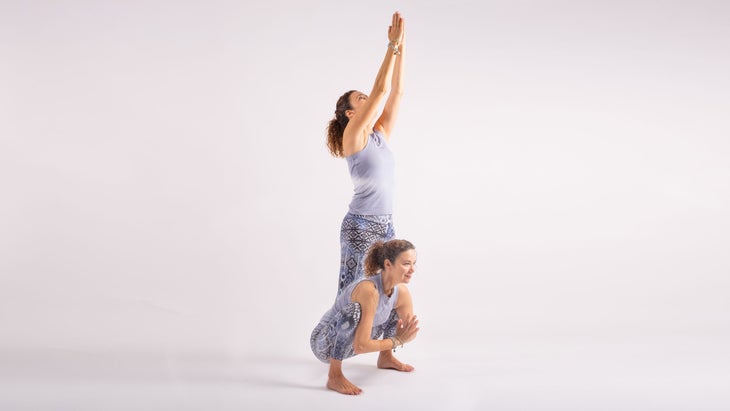
Malāsana (Garland Pose) flow (squat lifts)
From Wide-Legged Standing Forward Bend, inhale and lengthen your spine with your arms long. Exhale and walk your hands to the front of the mat, pivoting into Low Lunge. Then bring your back foot forward to just outside your left hand and, with bent knees, slowly come to stand at the front of the mat. Keep your feet wide but bring them parallel to one another. Inhale and lift your hands in prayer, then slowly sit your seat back halfway to squat as you continue to track your knees in the same direction as your toes. Stay here or slowly come down into a squat while keeping your feet parallel. On an inhale, press into your heels to lift. Repeat 5–10 times. Even if you’re only going halfway down, you can receive the same benefit.

Kakasana (Crow Pose), variation
Although the traditional Crow Pose involves touching the feet together and lifting them up toward your seat, this variation on Crow Pose can feel more grounding—and is a fantastic entry point for new flyers.
From squat, straighten your legs and come into Standing Forward Bend. Shake out your legs a little if they are feeling those squats. Come into half squat again but place your hands on the mat shoulder-distance apart as if to come into Plank. Bend your elbows about 90 degrees back as if to come into Chaturanga, lean forward, and place your knees or thighs on the outside of your upper arms (you may have to lift or lower your seat to aim the knees above the elbows). Slowly tip yourself slightly forward like a seesaw until your feet become light. Allow them to lift, and hug your legs into your arms. If it feels like you are tipping forward too much, press into your fingers as if they were on the brakes. When you are ready, lower your feet to the mat. Keep playing with it.
See also: How to Overcome Your Fear of Faceplanting
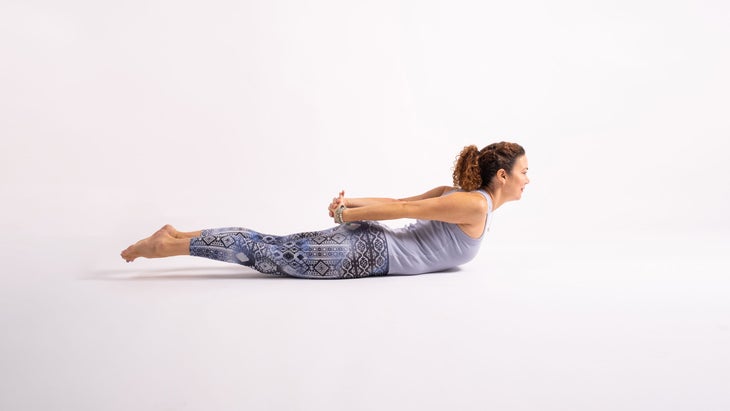
Salabhasana (Locust Pose)
Step your feet back to Plank and slowly lower yourself to the ground. Take a brief rest and feel your belly move with the breath against the earth. Lace your fingers behind your back (or grab a strap or towel with both hands behind your low back). Touch your big toes together—your heels can be a wide as is comfortable. Turn your chin or nose to the mat and on an inhale lift your arms, legs, and chest off the mat. Remain here for 3–5 breaths, lifting more on the inhale without throwing your head backward. Come down with control and rest. Turn your head to one side. Repeat it, if you can, lacing your hands with the other thumb on top. Turn your head to the other side and rest.
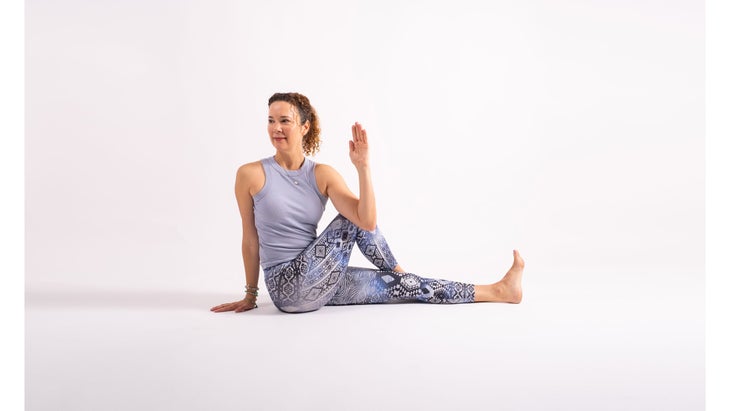
Ardha Matsyendrasana (Half Lord of the Fishes Pose)
From Locust Pose, slide your hands beneath your shoulders and press up to Tabletop. Take Cat and Cow and settle into Balasana (Child’s Pose) for several breaths. Slowly roll upright and swing your legs around to sit with your legs straight and long.
Bend your right knee and place your right foot on the outside of your left leg with the heel near your knee. Inhale and reach your left arm up, then turn to the right, hooking your left elbow outside the right knee (or just hug the knee to your chest if it feels more natural). Look anywhere that feels comfortable for your neck, and focus on rotating from your center with your spine as the axis. Listen to the body while breathing deeply and give the gut and low back just enough twist for a feeling of “rinsing” without force or strain. After 5 breaths, gently release and twist on the other side.

Janu Sirsasana (Head-of-the-Knee Pose)
From Half Lord of the Fishes Pose on the second side, lower your left knee open toward the mat (or prop it up with a pillow). Place your left foot on the inside of the right thigh in same shape as Vrksasana (Tree Pose). With a long spine, turn your upper body to line up your sternum with your straight right leg. Forward bend over the leg or twist a little to the right to lengthen through your left side. Allow yourself to relax here for as long as 2 minutes, keeping your arms and legs relaxed. Slowly roll up to sit slowly, and practice the pose on the other side.
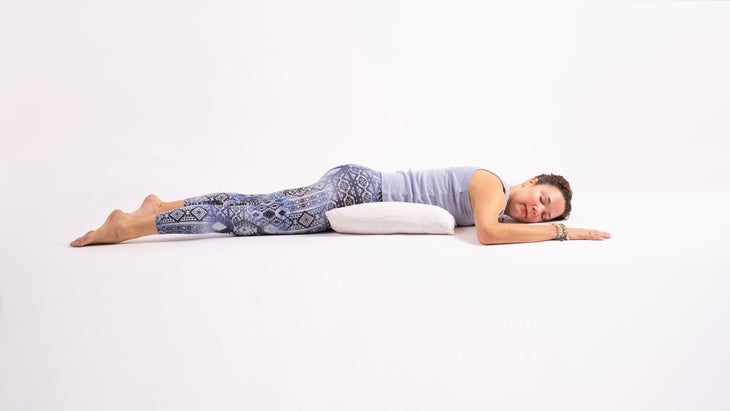
Savasana (Prone Corpse Pose), variation
Not all practitioners find Savasana (Corpse Pose) relaxing. If it’s been a whirlwind of a day (or a year), practice the pose facing the earth while taking support.
Find a pillow and place it across the center of your mat. Lie down with the pillow under your hips so that your upper body is tilting down in a subtle forward bend. Get comfortable, bringing your arms out to the side with bent elbows or stacking your hands as a pillow for your head. Let your body settle into whatever is beneath you. As time progresses, you may notice how the low back and even the sacral area respond to the gentle rocking of the breath. Relax completely, allowing any unhelpful thoughts to seep down into the receptive and supportive earth.
See also: 3 Vata-Balancing Recipes That May Become Your New Fall Favorites
About our contributor
Dana Slamp is a writer, a certified yoga therapist, and the Founder of Prema Yoga Institute, New York’s IAYT-accredited yoga therapy school. Her background in the arts and spirituality informs all that she creates. Dana has presented at Yoga Journal Conference, Telluride Yoga Festival, and teaches retreats and workshops internationally. She’s delighted to offer the IAY Yoga Therapy Program, an online RYT500 course and more alongside PYI’s diverse faculty at www.premayogainstitute.com. A self-confessed “Dog Mom,” Dana currently lives near Central Park with her dog Cooper. For online classes with Dana, check out Equinox+ and YogaAnytime.